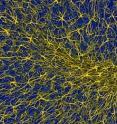Sex hormone precursor inhibits brain inflammation
Related images
(click to enlarge)
Researchers at the University of California, San Diego School of Medicine have discovered a steroid hormone that inhibits inflammation in the brain. The findings, to be published in the May 13 issue of the journal Cell, have implications for understanding the exaggerated inflammatory responses that are characteristic features of numerous neurodegenerative diseases. The discovery that the steroid hormone ADIOL, (5-androsten-3Β-17Β-diol), a precursor of androgens and estrogens, modulates inflammation induced by microglia cells could eventually lead to new treatments for patients with neurodegenerative conditions in which inflammation plays a pathogenic role. In addition, levels of ADIOL in blood or other body fluids might be useful for predicting risk or responses to drugs that mimic its actions.
The senior author of the paper is Christopher Glass, MD, PhD, professor of the department of cellular and molecular medicine and the department of medicine. Lead author is Kaoru Saijo, MD, PhD, and an associate project scientist in the Glass lab.
Though neurons get the headlines, they thrive only with the support of other cell types, among them microglia and astrocyte cells. Microglial cells help the central nervous system respond to infection and injury. Under normal conditions, they exist in a resting state, quietly but constantly surveying their surrounding environment for tell-tale indications of microbial invasion or tissue damage. Once detected, microglia initiate an inflammatory response, kick-starting immune system and tissue repair processes. Astrocytes amplify the immune reaction launched by microglia.
The microglia-astrocyte activation is vital to an effective immune response and damage repair, but if the resulting inflammation induced by these cells is not controlled or goes on too long, it can result in damage and death to neurons. Inflammation run amok is linked to many neurodegenerative diseases, such as Parkinson's disease, HIV-associated dementia, Alzheimer's disease and amyotrophic lateral sclerosis (ALS or Lou Gehrig's disease), and some inflammatory diseases like multiple sclerosis (MS).
The new findings suggest that in healthy brains, microglia inflammation is modulated by the production of the steroid hormone ADIOL, which instructs support cells to calm down and return to their quiescent state. ADIOL works by binding to a transcription factor called estrogen receptor Β, which gets its name because of its similarity to estrogen receptor Β and its ability to bind to the female sex hormone estrogen. Unexpectedly, while ADIOL binding causes estrogen receptor α to execute an anti-inflammatory set of instructions to microglia and astrocytes, estrogen binding does not. Because of this, estrogens can actually antagonize the anti-inflammatory actions of ADIOL.
Glass and Saijo made their discovery based upon initial studies with John Katzenellenbogen, PhD, at the University of Illinois, Urbana-Champaign. Kaztenellenbogen's laboratory developed a number of synthetic small molecules that could bind very tightly and specifically to estrogen receptor .
Saijo at UC San Diego tested each of these compounds and found that some were potent inhibitors of inflammatory responses of microglia and astrocytes, while others were not. When one of these compounds was tested in vivo, it was found to strongly inhibit inflammation in the brain and to induce remission in a mouse model of multiple sclerosis.
Although estrogen itself can be neuroprotective, its lack of ability to induce the anti-inflammatory activity of estrogen receptor led to a search for endogenous or internal molecules that might have similar activities to the synthetic compounds. Saijo worked with Andrew Li, MD, assistant adjunct professor of medicine at UC San Diego, to ultimately identify ADIOL as the endogenous regulator of estrogen receptor activity. Notably, Saijo and Li found that the amount of ADIOL that could be produced by microglia was regulated by signals that control the magnitude and duration of inflammatory responses
"We think it possible that mutations in the genes encoding the key enzymes for the generation of ADIOL, or their inappropriate down-regulation, could contribute to pathological forms of inflammation," Glass said.
These findings raise the possibility that women are more susceptible to certain inflammatory diseases, such as MS, because their higher levels of estrogens potentially antagonize the anti-inflammatory actions of ADIOL in the brain. A similar argument might also help explain some of the adverse effects of estrogen administration on the brain in post-menopausal women.
Glass noted, however, that much research remains to be done. The precise relationship between brain inflammation and neurodegenerative disease, for example, is not fully understood. Similarly, it's not known whether people naturally produce different amounts of ADIOL. And researchers have only identified the ADIOL-estrogen connection in an MS mouse model. Glass said he and colleagues will next look at animal models for Alzheimer's, Parkinson's and HIV-dementia.
Source: University of California - San Diego
Articles on the same topic
- Estrogen receptors play anti-inflammatory role in the brainThu, 12 May 2011, 18:37:07 UTC
Other sources
- Sex hormone precursor inhibits brain inflammation: Molecule moderates condition linked to neurodegenerative diseasesfrom Science DailyThu, 12 May 2011, 18:21:33 UTC
- Sex hormone precursor inhibits brain inflammationfrom PhysorgThu, 12 May 2011, 16:30:38 UTC
